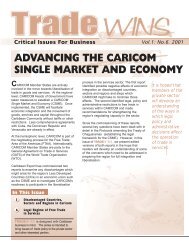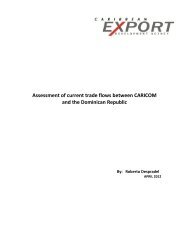The Furniture Manufacturing Industry of Barbados - Caribbean ...
The Furniture Manufacturing Industry of Barbados - Caribbean ...
The Furniture Manufacturing Industry of Barbados - Caribbean ...
You also want an ePaper? Increase the reach of your titles
YUMPU automatically turns print PDFs into web optimized ePapers that Google loves.
4.3 Selecting the right product(s)<br />
4.3.1 Barbadian standards: Product pre-selection by the Historical Committee<br />
After having conducted an audit <strong>of</strong> historical pieces available in <strong>Barbados</strong>, the Historical<br />
Committee has set up a list <strong>of</strong> standards, i.e. pieces <strong>of</strong> furniture that could be included in a<br />
“Barbadian Vernacular” product line. <strong>The</strong> pieces are those that best capture the spirit <strong>of</strong> old-<br />
<strong>Barbados</strong> and the breezy elegance <strong>of</strong> its furniture. Samples will be photographed and compiled<br />
in a catalogue for reference.<br />
This pre-selection <strong>of</strong> standards on which the further promotion <strong>of</strong> “Barbadian Vernacular”<br />
should be built has been the major outcome <strong>of</strong> the work <strong>of</strong> this Historical Committee. <strong>The</strong><br />
final selection <strong>of</strong> pieces, their detailed description/documentation and a selection <strong>of</strong> the<br />
craftsmen who will be entrusted with their manufacturing are yet to be done.<br />
To give the process attention by the wider public, the selection <strong>of</strong> prototypes itself could become<br />
the subject <strong>of</strong> a PR campaign. Short-listed craftsmen will be asked to come up with<br />
their interpretation <strong>of</strong> the pre-selected products for the three pre-defined product lines<br />
within two months <strong>of</strong> the announcement. <strong>The</strong> winners <strong>of</strong> the design competition will be<br />
awarded contracts to produce the award-winning pieces under the label “Barbadian Vernacular”.<br />
<strong>The</strong> right to market these pieces is to be subrogated to the “Barbadian Vernacular”<br />
marketing board, a private entity.<br />
Most <strong>of</strong> the antique furniture that have been passed on from generation to generation in <strong>Barbados</strong><br />
and that can still be found today dates from the 19 th century. While the early colonial<br />
merchants and planters had furnished their spacious homes with furniture imported from<br />
Europe, it soon become obvious that these imports could not resist the tropical climate with<br />
its heat and humidity, and insects; the island termites feasted on the European s<strong>of</strong>twoods<br />
and the heat dried the glue and evaporated it. Out <strong>of</strong> necessity to have more durable and<br />
more adapted replacements that own furniture were manufactured in <strong>Barbados</strong>, copying the<br />
styles <strong>of</strong> the imports.<br />
<strong>The</strong> first joiners were trained as shipwrights and plantation carpenters who would craft furniture<br />
from indigenous hardwoods, mainly mahogany. European, neo-classical and even<br />
colonial Anglo-Indian influences percolated here and many West Indian pieces show an intriguing<br />
mixture <strong>of</strong> styles. <strong>The</strong> various strains could easily meld in one piece “leaving the<br />
uninitiated viewer today charmed but slightly bewildered” (M. Connors). <strong>Caribbean</strong> joiners<br />
and cabinet-makers crafted their own highly stylised motifs such as pineapples, sunbursts,<br />
sandbox fruit, banana leaves, palm fronds and nutmeg fruits.<br />
But the differences in style will only be perceived by the connoisseur and generally speaking<br />
Barbadian furniture that speak to an English heritage do have a comparative advantage<br />
when addressing consumers in the US market.<br />
Original pieces from the colonial era are hard to come by these days. Also, they are to precious<br />
for the rough-and-tumble <strong>of</strong> everyday use. Beautifully crafted reproductions have<br />
therefore come to the market, both in <strong>Barbados</strong> and in the US. <strong>The</strong>se reproductions respond<br />
much better to today’s way <strong>of</strong> living with smaller rooms, a preference for lighter colours, the<br />
heating and air-conditioning <strong>of</strong> rooms and a generally more mobile/flexible lifestyle that<br />
requires occasional relocations. Further to this, the contemporary styles <strong>of</strong> production favour<br />
simpler designs that are less labour-intensive to manufacture than antique furniture.













